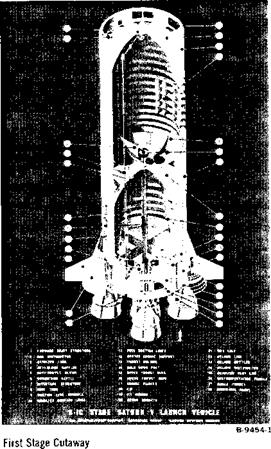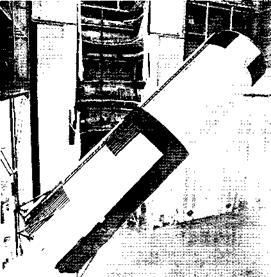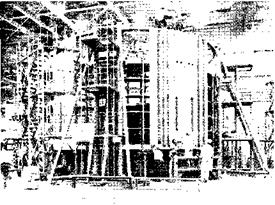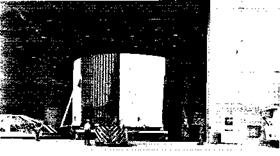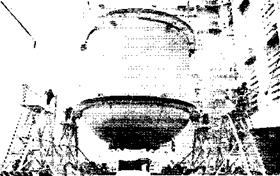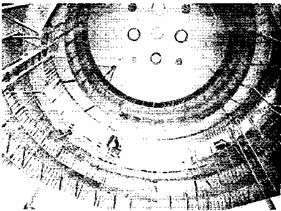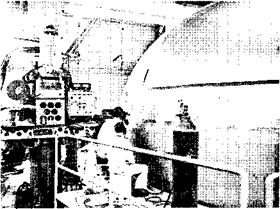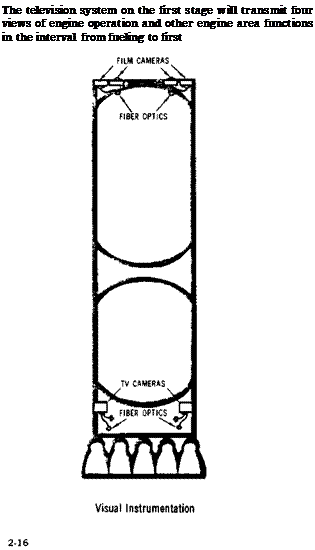While a major effort of this country’s space commitment was to explore the moon, the broader target was to build a capability—people, launch vehicles, propulsion, spacecraft, production, testing, and launching sites —to explore a vast new frontier and develop a long-range spacefaring capability that would establish continuing national preeminence.
The questions facing national space planners in 1961 and 1962 were complex. Although the use of a Saturn I for a manned lunar landing was theoretically possible, it would have been extremely difficult. About six Saturn I launches would have been required, their payloads being assembled in earth orbit to form a moon ship. No space rendezvous and docking had taken place at that time.
During the first half of 1962, two paramount decisions were announced: to develop a new general purpose launch vehicle in the middle range of several under consideration, and to conduct the manned lunar landing by use of a lunar orbit rendezvous (LOR) technique.
The Saturn V, as the chosen vehicle was named, was given the go-ahead in January, 1962.
It was to be composed of three propulsive stages and a small instrument unit to contain guidance and control. It could perform earth orbital missions through the use of the first two stages, while all three would be required for lunar and planetary expeditions. The ground stage was to be powered by five F-l engines, each developing 1.5 million pounds of thrust, and the stage would have five times the power of the Saturn I booster then under development. The upper stages would use the J-2 hydrogen/ oxygen engine, five in the second stage and one in the third. Each would develop up to 225,000 pounds of thrust. Such a rocket would be capable of placing 120 tons into earth orbit or dispatching 45 tons to the moon. (The numbers have been uprated now to about 125 and 47-1/2.)
During its assembly, checkout, and launch, the Saturn V7 would use a new mobile launch concept. It would be assembled in a huge Vehicle Assembly Building, and then transported in an upright position to a launch pad several miles away.
Propulsion development decisions preceded those for the vehicles.
The need for a building-block rocket engine in the million-pound-thrust class was apparent even as ARPA was ordering work to begin on the first stage cluster of engines for the Saturn I. In January, 1959, NASA contracted with North American Aviation’s Rocketdyne Division for development of the F-l.
Late in 1959, the Silverstein Committee recommended the development of a new high-thrust hydrogen engine to meet upper stage requirements. In June, 1960, Rocketdyne was selected to develop the J-2 engine after evaluation of competitive proposals by NASA.
Three proposed Apollo modes which were considered in detail were: the direct flight mode, using a very large launch vehicle called "Nova”; the earth orbital rendezvous (EORI mode, requiring separate Saturn launches of a tanker and a manned spacecraft; and the lunar orbital rendezvous mode, requiring a single launch of the manned spacecraft and the lunar module.
Selected was the LOR mode, in which the injected spacecraft weight would be reduced from 150,000 pounds to approximately 80,000 pounds by eliminating the requirement for the propulsion needed to soft-land the entire spacecraft on the lunar surface.
A small lunar excursion module, or LEM, now referred to as the lunar module, would be detached after deboost into lunar orbit. The lunar module would carry two of the three-man Apollo crew to a soft landing on the moon and would subsequently be launched from the moon to rendezvous with the third crew member in the “mother ship.” The entire crew would then return to earth aboard the command module.
NASA concluded that LOR offered the greatest assurance of successful accomplishment of the Apollo objectives at the earliest practical date.
Members of NASA’s Manned Space Flight Management Council recommended LOR unanimously in 1962 because it:
1. Provided a higher probability of mission success with essentially equal mission safety;
2. Promised mission success some months earlier than did other modes;
3. Would cost 10 to 15 per cent less than the other modes; and
4. Required the least amount of technical development beyond existing commitments while advancing significantly the national technology.
As a part of the Saturn V decision, it was deter-
1-5
mined that elements of the existing Saturn I vehicle and the planned Saturn V would be combined to form a new mid-range vehicle, the uprated Saturn I (Saturn IB), The Uprated Saturn I would have a payload capability 50 per cent greater than the Saturn I and would make possible the testing of the Apollo spacecraft in earth orbit about one year earlier than would be possible with the Saturn V.
By the end of 1962, all elements of the new program were under way, with the Marshall Space Flight Center directing the work for NASA. The Boeing Company; Space Division of North American Aviation, Inc.; and Douglas Aircraft Company were acting as prime contractors for the Saturn V first, second, and third stages, respectively. Engines were being developed by the Rocketdyne Division of North American. MSFC designed the instrument unit and awarded a production contract to International Business Machines Corp. (Chrysler Corp. had been selected to produce the first stage of the Uprated Saturn I.)
A large network of production, assembly, testing, and launch facilities was also being prepared by the end of 1962. Aside from the provision of various facilities at contractor plants and the augmentation of the Marshall Space Flight Center resources, three new government operations were established: the launch complex in Florida operated by the NASA – Kennedy Space Center and two new elements of MSFC—Michoud Assembly Facility in New Orleans, La., for the production of boosters, and Mississippi Test Facility, Bay St. Louis, Miss., for captive firing of stages.
Four years after its establishment, the Saturn V program was progressing on schedule, pointing toward the launch of the first vehicle in 1967 and fulfillment of the manned lunar landing before the end of the decade.
PROGRAM HIGHLIGHTS
Following are highlights of the Saturn V development program:
1961
Aug. 24 NASA announced the selection of the 88,000-acre site at Merritt Island, Fla., adjacent to Kennedy Space Center, then Cape Canaveral, for the assembly, checkout, and launch of the Saturn V.
Sept. 7 NASA selected the government-owned Michoud plant, New Orleans, as production site for Saturn boosters. It became a part of the Marshall Space Flight Center.
Sept. 11 NASA selected North American Aviation, Inc., to develop and build the second stage
for an advanced Saturn launch vehicle (as yet undefined) for manned and unmanned missions. One month later the Marshall Center directed NAA to design the second stage using five J-2 engines. A preliminary contract was signed in February, 1962.
Oct. 6 NASA selected the Picayune-Bay St. Louis, Miss., area for its Mississippi Test Facility — an arm of the Marshall Center —for use in static testing of rocket stages and engines.
Dec. 15 The Boeing Company was selected as prime contractor for the first stage of the advanced Saturn vehicle —not yet fully defined. A preliminary contract was signed in February, 1962, with the work to be conducted at the Michoud Assembly Facility.
Dec. 21 NASA selected the Douglas Aircraft Company to negotiate a contract to develop the third stage (S-IVB) of the advanced Saturn, based on the Saturn I’s S-IV stage. A supplemental contract for production of 11 third stages was signed in August, 1962.
1962
Jan. 10 Announcement was made that the advanced Saturn vehicle would have a first stage powered by five F-l engines, a second stage powered by five J-2 engines, and for lunar missions a third stage with one J-2 engine.
Jan. 25 NASA formally assigned development of the three-stage Saturn C-5 (Saturn V became the name in February, 1963) to MSFC.
April 11 NASA Headquarters gave the Apollo/ Saturn I/Saturn V highest national priority.
May 26 Rocketdyne Division of NAA conducted the first full-thrust, long-duration F-l engine test.
July 11 It was announced that the Saturn IB (Uprated Saturn I) would be developed and that the lunar orbit rendezvous method of accomplishing a lunar landing had been selected.
Decern – The U. S. Army Corps of Engineers
ber awarded a contract for the design of the Vehicle Assembly Building (VAB) at the Florida launch complex.
1963
Feb. 27 The first contract for the Mississippi Test Facility (MTF) Saturn V test facilities was awarded.
May The J-2 engine was successfully fired for the first time in a simulated space altitude of 60,000 feet.
Oct. 31 The Marshall Center received the first production model of the F-l engine.
Nov. 12 NASA contracted for the first Saturn V launch pad at the Kennedy Space Center.
1964
March IBM was awarded an instrument unit contract for the digital computer and data adapter by the Marshall Center. IBM became the prime IU contractor in May.
Oct. 9 The Edwards AFB test facility was accepted as the F-l test complex, amounting to a cost of $34 million.
Dec. 1 The first mainstage shakedown firing of the third stage battleship was accomplished, lasting 10 seconds.
Dec. 23 First full-duration firing of the third stage battleship occurred.
1965
April 16 All five engines of the S-IC-T, first stage test vehicle, were fired at the Marshall Center for 6.5 seconds.
April 24 The first cluster ignition test of the second stage battleship was successfully completed.
Aug. 5 The first full-duration firing of the first
stage was conducted successfully at the Marshall Center.
Aug. 8 Third stage flight readiness test of 452 seconds, fully automated, was accomplished at Sacramento.
Aug. 13 The IU was qualified structurally and man
rated for Saturn V use by withstanding a 140 per cent load limit.
Aug. 17 The third stage battleship was tested in Saturn V configuration for full duration (start-stop-restart).
Dee. 16 The S-IC-T static firings were completed at the Marshall Center with a total of 15 firings—three of full duration.
1966
Feb. 17 The S-IC-1 underwent static firing at the
& 25 Marshall Center and required no more static firings.
Mar. 30 The S-IU-500F was mated to the three stages of the Saturn V facilities vehicle at the Kennedy Space Center’s VAB.
May 20 First full-duration firing of the second stage flight stage was conducted at MTF.
May 25 The Apollo/Saturn V facilities vehicle, AS – 50Q-F, was transported to Pad A at Launch Complex 39, KSC, on the crawler.
May 26 Full-duration acceptance firing of the S – IVB-501, the first flight version of the third stage for Saturn V, was accomplished.
Septem – The F-l and J-2 engines were qualified for
ber manned flights.
Dec. 1 Initial static firing of the first flight version of the second stage occurred at MTF.
Nov. 15 The first flight version of the first stage was static fired at MSFC.
|
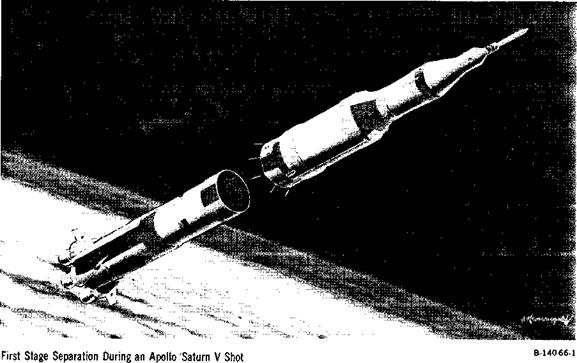
1-7
|
|
j| SATURN V NEWS REFERENCE
FIRST STAGE FACT SHEET
33′
WEIGHT: 300,000 lb. (dry)
4,792,0 lb. (loaded)
DIAMETER: 33 ft.
HEIGHT: 138 ft.
BURN TIME: About 2.5 min.
VELOCITY: 6,000 miles per hour at burnout (approx.)
ALTITUDE AT BURNOUT: About 38 miles
MAJOR STRUCTURAL COMPONENTS
THRUST STRUCTURE FUEL TANK INTERTANK LOX TANK FORWARD SKIRT
MAJOR SYSTEMS
PROPULSION: Five bipropellant F-l engines Total thrust: 7.5 million lb.
Propellant: RP-1- 203,000 gal. or 1,359,000 lb.
LOX—331,000 gal or 3,133,000 lb.
Pressure: Control 1.27 cubic feet of gaseous nitrogen at 3,250 psig
Fuel pressurization – 124 cubic feet or 636 lb. of gaseous helium at 3,100 psig LOX pressurization gaseous oxygen converted from 6,340 pounds of LOX by the engines HYDRAULIC: Power primarily for engine start and for gimbaling four outboard engines ELECTRICAL: Two 28 VDC batteries, basic power for all electrical functions INSTRUMENTATION: Handles approx. 900 measurements TRACKING: ODOP Transponder
і SATURN V NEWS REFERENCE














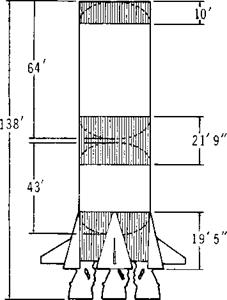
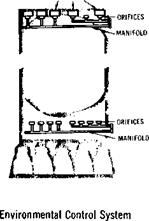
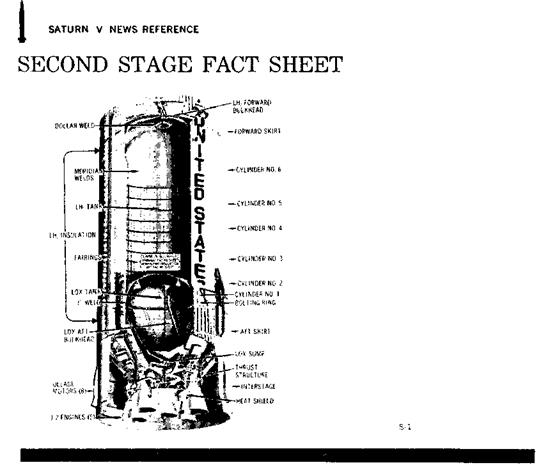

 Facility Vehicle at Ramp of Launch Pad
Facility Vehicle at Ramp of Launch Pad